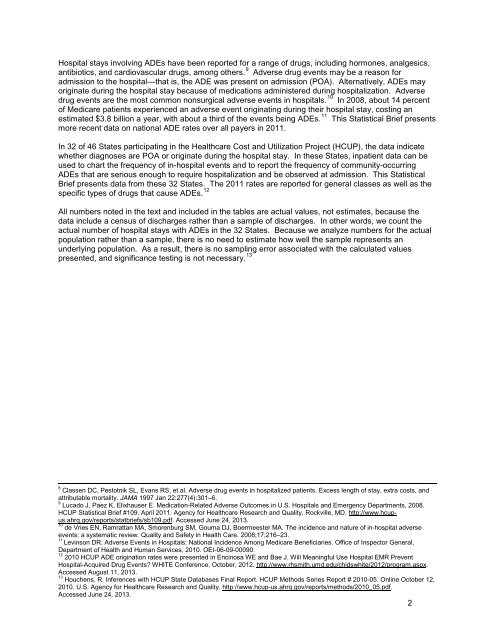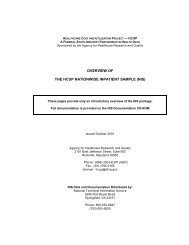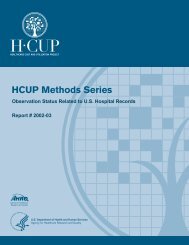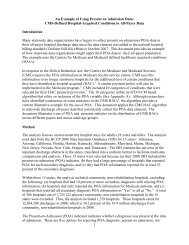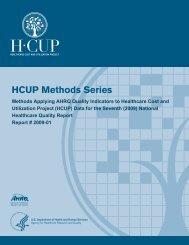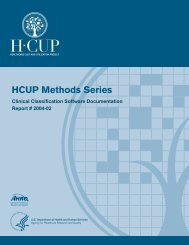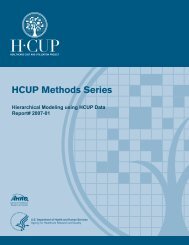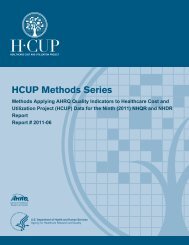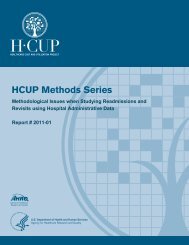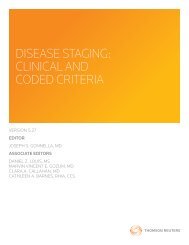Origin of Adverse Drug Events in U.S. Hospitals, 2011 - HCUP
Origin of Adverse Drug Events in U.S. Hospitals, 2011 - HCUP
Origin of Adverse Drug Events in U.S. Hospitals, 2011 - HCUP
Create successful ePaper yourself
Turn your PDF publications into a flip-book with our unique Google optimized e-Paper software.
Hospital stays <strong>in</strong>volv<strong>in</strong>g ADEs have been reported for a range <strong>of</strong> drugs, <strong>in</strong>clud<strong>in</strong>g hormones, analgesics,<br />
antibiotics, and cardiovascular drugs, among others. 9 <strong>Adverse</strong> drug events may be a reason for<br />
admission to the hospital—that is, the ADE was present on admission (POA). Alternatively, ADEs may<br />
orig<strong>in</strong>ate dur<strong>in</strong>g the hospital stay because <strong>of</strong> medications adm<strong>in</strong>istered dur<strong>in</strong>g hospitalization. <strong>Adverse</strong><br />
drug events are the most common nonsurgical adverse events <strong>in</strong> hospitals. 10 In 2008, about 14 percent<br />
<strong>of</strong> Medicare patients experienced an adverse event orig<strong>in</strong>at<strong>in</strong>g dur<strong>in</strong>g their hospital stay, cost<strong>in</strong>g an<br />
estimated $3.8 billion a year, with about a third <strong>of</strong> the events be<strong>in</strong>g ADEs. 11 This Statistical Brief presents<br />
more recent data on national ADE rates over all payers <strong>in</strong> <strong>2011</strong>.<br />
In 32 <strong>of</strong> 46 States participat<strong>in</strong>g <strong>in</strong> the Healthcare Cost and Utilization Project (<strong>HCUP</strong>), the data <strong>in</strong>dicate<br />
whether diagnoses are POA or orig<strong>in</strong>ate dur<strong>in</strong>g the hospital stay. In these States, <strong>in</strong>patient data can be<br />
used to chart the frequency <strong>of</strong> <strong>in</strong>-hospital events and to report the frequency <strong>of</strong> community-occurr<strong>in</strong>g<br />
ADEs that are serious enough to require hospitalization and be observed at admission. This Statistical<br />
Brief presents data from these 32 States. The <strong>2011</strong> rates are reported for general classes as well as the<br />
specific types <strong>of</strong> drugs that cause ADEs. 12<br />
All numbers noted <strong>in</strong> the text and <strong>in</strong>cluded <strong>in</strong> the tables are actual values, not estimates, because the<br />
data <strong>in</strong>clude a census <strong>of</strong> discharges rather than a sample <strong>of</strong> discharges. In other words, we count the<br />
actual number <strong>of</strong> hospital stays with ADEs <strong>in</strong> the 32 States. Because we analyze numbers for the actual<br />
population rather than a sample, there is no need to estimate how well the sample represents an<br />
underly<strong>in</strong>g population. As a result, there is no sampl<strong>in</strong>g error associated with the calculated values<br />
presented, and significance test<strong>in</strong>g is not necessary. 13<br />
8 Classen DC, Pestotnik SL, Evans RS, et al. <strong>Adverse</strong> drug events <strong>in</strong> hospitalized patients. Excess length <strong>of</strong> stay, extra costs, and<br />
attributable mortality. JAMA 1997 Jan 22:277(4):301–6.<br />
9 Lucado J, Paez K, Elixhauser E. Medication-Related <strong>Adverse</strong> Outcomes <strong>in</strong> U.S. <strong>Hospitals</strong> and Emergency Departments, 2008.<br />
<strong>HCUP</strong> Statistical Brief #109. April <strong>2011</strong>. Agency for Healthcare Research and Quality, Rockville, MD. http://www.hcupus.ahrq.gov/reports/statbriefs/sb109.pdf.<br />
Accessed June 24, 2013.<br />
10 de Vries EN, Ramrattan MA, Smorenburg SM, Gouma DJ, Boermeester MA. The <strong>in</strong>cidence and nature <strong>of</strong> <strong>in</strong>-hospital adverse<br />
events: a systematic review. Quality and Safety <strong>in</strong> Health Care. 2008;17;216–23.<br />
11<br />
Lev<strong>in</strong>son DR. <strong>Adverse</strong> <strong>Events</strong> <strong>in</strong> <strong>Hospitals</strong>: National Incidence Among Medicare Beneficiaries. Office <strong>of</strong> Inspector General,<br />
Department <strong>of</strong> Health and Human Services, 2010. OEI-06-09-00090.<br />
12 2010 <strong>HCUP</strong> ADE orig<strong>in</strong>ation rates were presented <strong>in</strong> Enc<strong>in</strong>osa WE and Bae J. Will Mean<strong>in</strong>gful Use Hospital EMR Prevent<br />
Hospital-Acquired <strong>Drug</strong> <strong>Events</strong>? WHITE Conference, October, 2012. http://www.rhsmith.umd.edu/chidswhite/2012/program.aspx.<br />
Accessed August 11, 2013.<br />
13 Houchens, R. Inferences with <strong>HCUP</strong> State Databases F<strong>in</strong>al Report. <strong>HCUP</strong> Methods Series Report # 2010-05. Onl<strong>in</strong>e October 12,<br />
2010. U.S. Agency for Healthcare Research and Quality. http://www.hcup-us.ahrq.gov/reports/methods/2010_05.pdf.<br />
Accessed June 24, 2013.<br />
2


